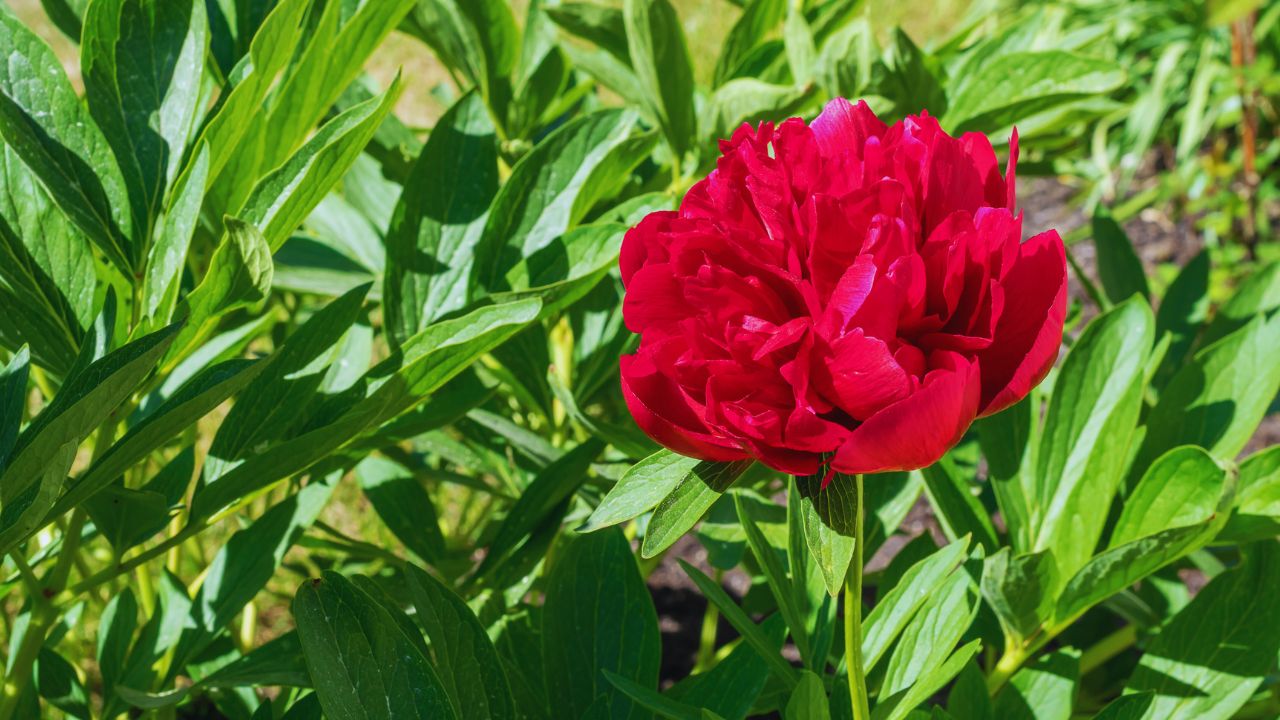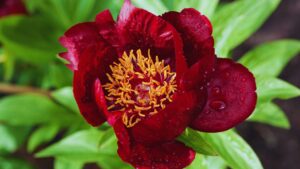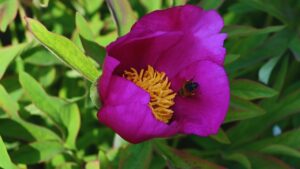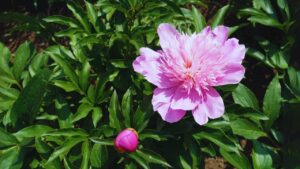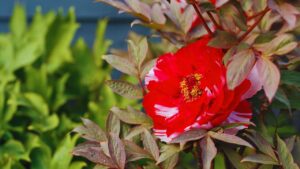Introduction
One of the most revered peony plants across the globe happens to be the Chinese peony (Paeonia lactiflora). For centuries human beings have cultivated this eminent plant because of its impressive fragrant flowers and cultural relevance throughout China and additional territories. People prize the Chinese peony both for its beautiful appearance and its double-value as medicine and ornamentation.
This paper reveals complete information concerning Chinese peony including its historical background as well as its features and requirements for planting and care and advantages.
History and Cultural Significance
Chinese peonies exist as an historic flower with an information that strains over again a couple of thousand years. Chinese culture has named the peony flower due to the fact the “King of Flowers” as it shows every prosperity and honor. Over centuries, this flower has been deeply embedded in the Chinese way of life, symbolizing wealth, beauty, and first rate fortune.
The imperial gardens of the Tang Dynasty maintained Chinese peony vegetation sooner or later of 618-907 AD at the identical time as poets and artists rose to realise these plants. Chinese festivals, collectively with conventional remedy, integrate this flower as in fact certainly one of its number one elements in contemporary-day-day times.
The peony moreover appears in ancient paintings, embroidery, and ceramics, reflecting its importance in Chinese artwork. Even in recent times, it remains a cherished flower in China and is regularly utilized in celebrations, weddings, and exclusive auspicious sports.
Botanical Characteristics of Chinese Peony
Appearance
As a herbaceous perennial plant, the Chinese peony grows up to 3 ft tall, forming a lush, bushy clump. Its dark green, clean leaves offer a tremendous evaluation to its stunning blooms. These deeply lobed leaves decorate the plant’s commonplace. Take a look at the identical time as moreover contributing to its resilience. Their dense nature makes peonies a first-rate desire for collectively with intensity and texture to any lawn panorama.
During fall, the foliage transitions to a reddish hue, which includes seasonal hobby in advance of the plant entering dormancy. The robust stems of the peony assist manual its huge flowers, however a few kinds may additionally moreover require greater staking. With the right care, Chinese peonies can live for decades, imparting regular splendor and a strong garden presence.
Flowers and Blooming Season
Chinese peonies are regarded for his or her massive, perfect blooms that might develop up to 8 inches in diameter. The flowering season lasts from past due spring to early summer season, inside the path of which peonies show their colorful colorings, which includes pink, crimson, white, and yellow. Some cultivars have characteristic double-layered petals, developing a high priced, ruffled appearance that enhances their beauty.
The blooming technique begins off with tightly closed buds that slowly open into entire blossoms. Some kinds change shade barely as they mature, consisting of greater seen hobby. The prolonged blooming duration ensures that peonies live a garden highlight for several weeks, making them a face amongst flower fans and landscape designers alike.
Fragrance
One of the maximum distinguishing skills of Chinese peonies is their awesome fragrance. Many cultivars launch a sweet, captivating perfume that draws pollinators like bees and butterflies, enriching the surrounding environment. The depth of the fragrance varies through variety, with a few emitting a robust, perfume-like aroma, even as others have a more touchy fragrance.
Their pleasant perfume makes Chinese peonies a pinnacle choice for reducing floral arrangements, filling indoor regions with a sparkling floral aroma. Even after being lessened, peonies preserve their perfume for several days. This enduring perfume, mixed with their hanging look, makes them a sought-after flower for bouquets and home decorations.
Read also: How to Grow and Care for Fern Leaf Peony
How to Grow Chinese Peony
Best Location for Planting
Chinese peonies thrive in places that get maintained as a minimum 6 to 8 hours of direct sunlight each day. While they tolerate partial color, inadequate daylight can motivate fewer and smaller blooms. A spot that receives morning daylight hours and some afternoon color works notable, particularly in regions with quite warm summers.
Good air flow into is critical to save you fungal ailments that may have an impact on peonies. It is likewise honestly useful to plant them in regions sheltered from strong winds, as their heavy blooms can droop or damage. Choosing the proper place allows peonies to grow vigorously, making sure healthy foliage and an abundance of flora every season.
Soil Requirements
Chinese peonies require well-draining, nutrient-rich soil with a barely acidic to independent pH amongst 6.Five and 7.Zero. If the soil is heavy with clay, which incorporates compost or herbs that improves drainage and forestalls water retention, that could cause root rot. Properly organized soil promotes stronger roots and additional healthy vegetation.
Organic amendments together with elderly manure, peat moss, or sand in addition beautify the soil’s fertility and aeration. Before planting, gardeners have to ensure the soil is free and rich in vitamins. Healthy soil gives the muse for sturdy growth, resulting in big, more vibrant blooms inside the course of the flowering season.
Planting Depth and Spacing
When planting Chinese peonies, it is essential to region the roots no deeper than 2 inches below the soil ground. If planted too deeply, peonies also can warfare to bloom, while shallow planting can divulge roots to harsh climate conditions, possibly poor their development. Proper planting depth guarantees healthy and everyday flowering.
Peonies must be spaced at the least 3 feet aside to permit for enough air flow into, lowering the opportunity of fungal infections. Adequate spacing moreover guarantees that each plant receives sufficient sunlight hours and nutrients, which permits produce fuller, extra colorful blooms. Well-spaced peonies create a beautiful scene effect in any garden.
Read also: Hybrid Peony: A Stunning Addition to Your Garden
Caring for Chinese Peony
Watering Requirements
Chinese peonies require deep watering, specially within the route of dry spells, to set up a robust root device. Watering as fast as in step with week is ideal, allowing moisture to gain deep into the soil and inspire strong root growth. However, overwatering ought to be prevented, as excessive moisture can result in root rot and fungal ailments.
To maintain proper hydration, peonies should be watered at the lowest in place of from above, which prevents greater moisture on leaves and reduces sickness danger. Mulching at some degree inside the base permits maintaining moisture and adjusting soil temperature. Ensuring balanced watering practices results in healthful flowers with extra active growth and lovely blooms.
Fertilization
A balanced fertilizer with a ten-10-10 ratio needs to be carried out in early spring to beneficial resource lively growth and massive blooms. The nitrogen promotes lush foliage, phosphorus encourages root improvement, and potassium enhances ordinary plant health. Using sluggish-launch fertilizers ensures a normal supply of nutrients at some degree in the growing season, preventing nutrient depletion.
A second fertilizer software program program after flowering strengthens the plant and prepares it for the next developing cycle. Organic compost, bone meal, or well-elderly manure can be characteristic natural options, enriching the soil without the threat of chemical buildup. Fertilization needs to be slight, as immoderate feeding can also motivate lush foliage at the price of blooms.
Mulching and Weed Control
Applying a 2 to a few-inch layer of herbal mulch inside the route of the bottom of Chinese peonies lets in keep moisture, modify soil temperature, and suppress weed boom. Mulching is particularly useful in warmness climates, wherein it prevents fast moisture loss from the soil. Common mulch materials include shredded bark, compost, straw, or pine needles.
The mulch has to now not be placed at once in opposition to the stems, as this may cause rot and fungal infections. Regularly replenishing mulch ensures its persisted effectiveness. Weed manipulation is vital while you don’t forget that weeds compete for nutrients and water. Hand-pulling weeds near peonies is remaining to avoid annoying the roots with mechanical systems.
Supporting the Blooms
Chinese peonies produce big, heavy blooms which could cause stems to bend or harm, particularly after rain. Installing peony jewelry, stakes, or plants early inside the season ensures flowers live upright. Proper help not terrific enhances the plant’s appearance however moreover prevents damage to the stems and buds.
For super results, stakes want to be located inside the soil at the time of planting to keep away from traumatic set up roots later. Some gardeners select the use of natural strategies, which includes tying the stems to a trellis or neighboring flowers. Supporting peonies efficiently allows them to keep their structural integrity and prolongs the beauty of their blooms.
Pruning and Maintenance
Deadheading After Blooming
Removing spent flora, or deadheading, redirects the plant’s power within the route of strengthening its roots and foliage in place of seed manufacturing. Using sharp, sterilized scissors, reduce faded flowers all the manner all of the manner down to the primary set of healthful leaves. This exercise no longer simply encourages better future blooms but moreover maintains the plant looking tidy.
Deadheading additionally prevents contamination thru casting off decaying plant cloth that might harbor fungi. Regularly reading and trimming any inclined or damaged stems promotes airflow and reduces the risk of infections. By maintaining a smooth and properly-pruned plant, gardeners make sure greater healthy increase and greater strong flowering within the following season.
Fall Pruning
In past due fall, lowering peony foliage proper right all the way down to the ground permits you to save you from fungal infections and pest infestations. Old stems want to be removed clearly and disposed of, as leaving them over wintry weather will increase the hazard of sickness. This is a critical step in preserving prolonged-time period plant health.
Gardeners must keep away from composting pruned material, as peony foliage regularly consists of pathogens. Instead, it wants to be discarded or burned. After pruning, making use of a light mulch layer protects the plant from excessive wintry climate conditions, even though it must be eliminated in early spring to permit new growth to emerge.
Read also: How to Grow and Care for Tree Peony
Propagation of Chinese Peony
Division Method
Chinese peonies are excellent propagated via department, a method that guarantees genetic consistency and quicker blooming. Mature vegetation wants to be divided each 4 to five years, ideally in early autumn while they may be dormant. Carefully dig up the plant, taking care not to damage the roots, and separate sections with at least three eyes (buds) every.
Each divided section has to be replanted immediately, placed on the right depth for max incredible boom. Providing enough water after department allows the extremely-current plants to set up themselves in advance than wintry weather. This method is the maximum dependable way to propagate peonies, as it produces vegetation hundreds sooner than developing from seeds.
Growing from Seeds
Growing Chinese peonies from seeds is an extended and slow technique, requiring persistence. Freshly harvested seeds must go through a chilly stratification length to break dormancy, mimicking wintry weather situations. This can take numerous months, and as quickly as germinating, seedlings need a couple of years to mature earlier than producing their first flora.
Seed-grown peonies often display genetic variants, that means the flowers may not resemble those of the determined plant. While this approach isn’t regularly used by gardeners due to its gradual tempo, it’s miles valuable for breeding new peony cultivars. For the ones seeking out faster effects, branch remains the preferred propagation method.
Winter Care for Chinese Peony
Chinese peonies have outstanding bloodless tolerance, surviving temperatures as low as -20°F (-29°C). However, in areas with harsh winters, using a thin defensive mulch layer over the ideal place lets in insulate against immoderate cold. This is especially useful for additional youthful or currently transplanted peonies, which may be more willing.
Winter mulch wants to be slight, collectively with straw or pine needles, to prevent excessive moisture buildup that would reason rot. It wants to be eliminated in early spring to allow new growth to emerge. In particularly bloodless climates, wrapping peony crowns in burlap offers extra safety in competition to frost harm.
Common Pests and Diseases of Chinese Peony
Chinese peonies are stated for their resilience, however they will however fall susceptible to numerous pests and ailments that negatively affect their increase, flowering, and essential health. These problems, if left untreated, can cause stunted growth, awful blooming, or possibly plant lack of existence. Early identification of not unusual pests and fungal infections will help gardeners take effective movement. Below are the maximum frequently encountered pests and ailments affecting Chinese peonies, at the facet of superb solutions to prevent and manipulate them efficiently.
Common Pests
1. Aphids
Aphids are tiny, gentle-bodied insects that cluster on new boom, stems, and flower buds, extracting sap from plant tissues. This weakens the Chinese peony through a manner of depleting vitamins, resulting in curled leaves, yellowing foliage, and stunted boom. Severe infestations may additionally result in bud deformation and failure to bloom. Aphids secrete a sugary substance referred to as honeydew, which draws ants and encourages the growth of sooty mold, further harming the plant.
Solution:
To control aphids, spray the plant with a strong float of water to dislodge them. Applying neem oil or insecticidal cleaning soap weekly can efficiently cast off infestations. Additionally, introducing natural predators like ladybugs and lacewings into the lawn permits aphid populations beneath to manage, selling an extra match peony plant.
2. Thrips
Thrips are slender, winged bugs that pierce the flower petals and leaves of Chinese peony to feed on plant juices. Affected vegetation may additionally moreover appear distorted, discolored, or streaked with silvery patches. In excessive instances, thrip harm can cause flower buds to drop earlier than setting up, reducing the visible attraction of the plant. Thrips multiply swiftly, making early detection crucial for effective management.
Solution:
Use yellow or blue sticky traps to show and capture thrips earlier than they become an extraordinary problem. Regularly utilizing neem oil, insecticidal cleaning cleaning soap, or horticultural oils can assist prevent infestations. Keeping the lawn free of weeds and plant particles gets rid of thrip breeding grounds, reducing the hazard of re-infestation.
3. Peony Leafminer
Peony leafminer larvae burrow through the inner tissues of leaves, developing winding tunnels that cause foliage to show brown and wither. This harm weakens the plant with the aid of lowering its capability to photosynthesize effectively. Over time, non-prevent leafminer infestations can stunt the peony’s increase, limit flower manufacturing, and make the plant extra susceptible to one of a kind strain elements.
Solution:
Manually eliminate and spoil inflamed leaves to forestall the spread. Encouraging natural predators which includes parasitic wasps can help lessen leafminer populations. If infestations persist, making use of pesticides particularly targeting leafminer larvae on the right developmental degree is an effective way to lower similar harm.
Common Diseases
1. Botrytis Blight (Gray Mold)
Botrytis blight is a common fungal disease that causes brown or gray mildew-blanketed lesions on flower buds, stems, and leaves. This illness flourishes in cool, humid environments, essential to rotting flowers and weak stems that collapse without problems. If left untreated, botrytis can rapidly spread and harm a whole peony plant, reducing its aesthetic value.
Solution:
To prevent botrytis blight, make sure proper spacing between flowers to beautify the air stream. Remove and put off inflamed plant fabric right away to prevent the spread. Avoid overhead watering, as excessive moisture encourages fungal boom. Spraying affected plants with a fungicide containing copper or sulfur can efficiently manipulate this sickness and prevent further outbreaks.
2. Powdery Mildew
Powdery mold seems as a thick, white, powder-like coating at the surfaces of peony leaves, buds, and stems. This fungal infection weakens the plant, limiting photosynthesis and resulting in distorted, yellowing foliage. Peonies in humid or shaded environments with horrific air move are mainly at risk of powdery mold. If no longer managed early, the sickness can lessen flower manufacturing and ordinary plant energy.
Solution:
Increase airflow around the plant with the useful resource of pruning overcrowded foliage and ensuring good enough spacing. Avoid immoderate nitrogen fertilizers, as they promote fast, clean booms that are greater liable to mildew. Organic treatments like baking soda or milk sprays can assist suppress moderate infections. For immoderate cases, utilizing sulfur-based fungicides presents powerful control.
3. Peony Wilt
Peony wilt, due to the fungal pathogen Cladosporium paeoniae, results in darkish, water-soaked lesions on stems and leaves, inflicting rapid wilting. This sickness progresses rapidly, with affected flowers collapsing inside days. Peony wilt frequently arises in damp, poorly ventilated areas, spreading through inflamed plant particles or infected soil. If left untreated, it could lead to complete plant loss.
Solution:
Immediately do away with and smash all infected plant fabric to prevent fungal spores from spreading. Improve soil drainage and avoid overwatering, as immoderate moisture accelerates illness development. Fungicide packages might also moreover help manipulate mild instances, but prevention thru right cultural practices is the best manner to maintain peonies disease-free.
4. Root Rot
Root rot occurs whilst Chinese peony are planted in poorly draining soil, leading to fungal infections that attack and decay the roots. Early signs and symptoms encompass yellowing leaves, wilting, and sluggish increase. If the infection progresses, the plant’s whole root tool can go to pot, in the long run causing it to collapse and die.
Solution:
Ensure chinese peony are planted in well-draining soil to save you immoderate moisture buildup. Avoid overwatering, especially in clay-heavy soils, which hold water longer. If root rot is detected, eliminate the affected plant, enhance soil conditions, and have a look at a fungicide before replanting. Consider the use of raised beds or amended soil to decorate drainage and prevent destiny occurrences.
Conclusion
An exceptional flowering plant named Chinese peony possesses great beauty combined with cultural value and adaptability in different applications. People treasure this plant as their meeting both decorative and medicinal purposes throughout gardens along with ornamental displays as well as medicinal practices worldwide. With proper care and understanding one can grow Chinese peonies successfully to enjoy their attractive flowers annually.
Read also: Paeonia obovata: A Rare and Beautiful Peony Species

